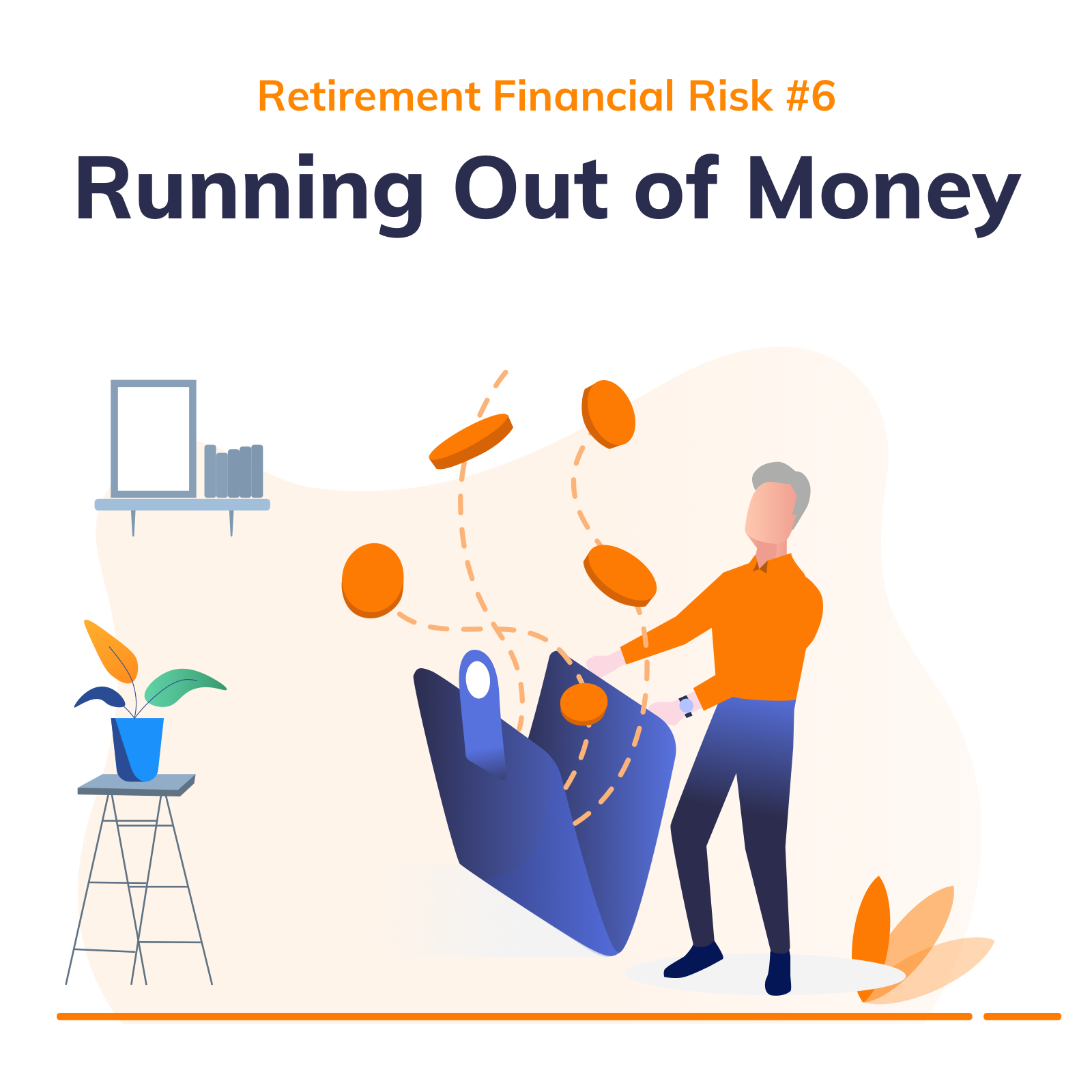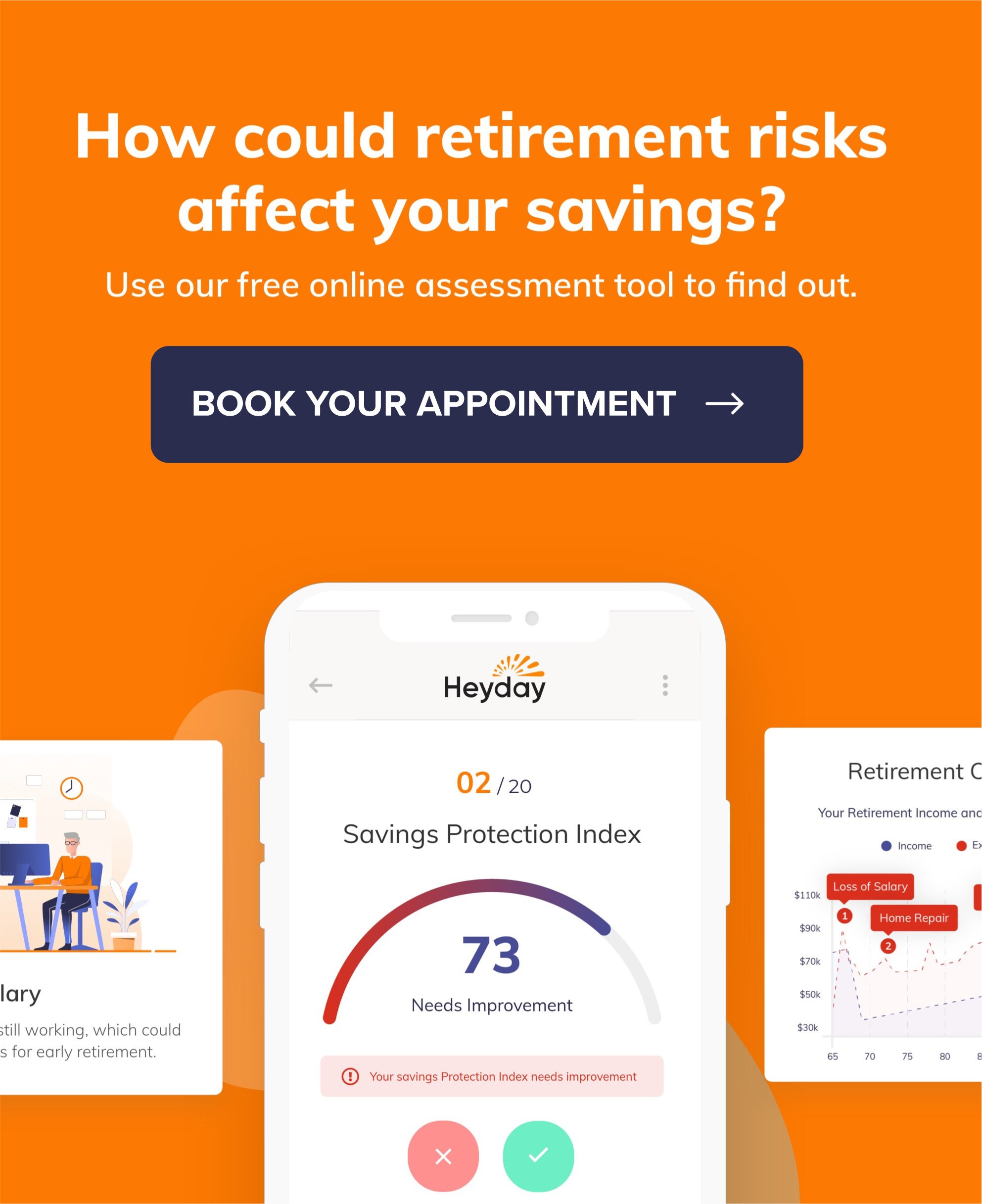Retirement Risk #6: Running Out of Money — A Real Fear That Can Derail Retirement
Making Our Savings Last Can Be Challenging
Running out of money has been a top concern for retirees for several years. Now, thanks to these uncertain times, it looks like it may be even more of a concern.
Retirement Concerns Up, Confidence is Down
A recent report on retirement security amid COVID-19 by Transamerica Center for Retirement Studies found:
- 23% of workers who are employed or recently unemployed have lost some confidence they will be able to retire comfortably.
- Of the Boomers surveyed, 32% said their confidence in being able to retire has gone down.
“Running out of money is consistently one of the main concerns for retirees, and it can affect all the other aspects of retirement planning.”
— Eric Stratton, Heyday founder
A Long List of Potential Financial Risks
Sadly, half of Americans believe they will outlive their savings. It could be a likely scenario for many, as it could result from one or any combination of other retirement risks:
- Longevity risk - While living a long life can be a tremendous gift, it also means our money needs to last longer in retirement. The interesting thing about longevity is that it’s a risk multiplier, so the older we get, the more exposure we have to all other financial risks that could contribute to outliving our money.
-
- Helping adult children - none of us may know when an adult child or grandchild may need a little financial help, which may not be a part of our retirement budget.
- Inflation - how much will inflation impact our retirement? Historical inflation rates can only give us hindsight. Yet, none of us truly know how much inflation will reduce our purchasing power over a 20- or 30-year retirement.
- Health care costs - another potential threat to retirement income can be health care costs throughout retirement. Whether we retire before Medicare kicks in or have significant prescriptions to consider, these costs can eat away at our nest eggs over time.
- Economic uncertainty - just like during our working years, there are several factors outside of our control that we may need to navigate in retirement. From market volatility to tax and public policy, we could face increased costs and reduced retirement income. For example, our current economic climate leaves many questions surrounding unemployment, interest rates, market performance and several other factors that could impact retirement.
- Withdrawal rate risk - how much can we safely withdraw each year and avoid spending our savings too quickly? The answer will be different for everyone and could vary year by year, depending on what’s happening with your investments. The 4% Rule, which advised withdrawing 4% of your savings each year may not work in all situations, especially during volatile markets.
- Health care costs - another potential threat to retirement income can be health care costs throughout retirement. Whether we retire before Medicare kicks in or have significant prescriptions to consider, these costs can eat away at our nest eggs over time.
- Inflation - how much will inflation impact our retirement? Historical inflation rates can only give us hindsight. Yet, none of us truly know how much inflation will reduce our purchasing power over a 20- or 30-year retirement.
- Caring for aging parents - some retirees may find themselves needing to help pay for the care of their aging parents, which can impact how much they can save for retirement, as well as how much retirement income they will have.
• Long-term care - the price tag of long-term care can be concerning for many retirees. According to Genworth’s 2019 Cost of Care Survey, the median cost for a semi-private nursing room is over $90,000 a year, which could significantly reduce most retirees’ savings.
Of course, there are additional risks not mentioned above. But these are some of the most common we’ve seen in working with hundreds of retirees.
Some Strategies to Prolong Our Savings May Have Consequences
To address these risks that only add fuel to the burning concerns about running out of money, retirees may:
Delay retirement as long as they can - working longer can potentially help those nearing retirement to earn more from Social Security while socking away even more of their wages for when they finally retire. However, working through what could be our most active and mobile retirement years can result in postponed retirement goals that may never come to fruition due to declining health.
Retire, but underspend and under live - it’s often difficult for savers to transition into spending their nest egg in retirement. This about-face in money habits, combined with fear of these potential risks and others may leave retirees to unnecessarily turn into spendthrifts. While cutting out discretionary spending and trying to live on Social Security alone may extend the life of retirement savings, it has the potential to cost retirees their lifetime of hard work and saving to enjoy that retirement reward.
Given a choice, most of us wouldn’t like the options presented above. But without the proper plan in place, retirees may spend their golden years so worried about money that they can’t enjoy this time they’ve worked so hard for.
Consider this example:
Mark and Mary Anne, both 66, are newly retired. So far, retirement isn’t living up to their expectations. As they adapt to their new routine and way of life, they find themselves more worried about money than ever before.
They worry about whether they’ll need long-term care later in life.
They check their account balances and the stock tickers constantly.
They’re having a difficult time taking money out of savings to pay for a nice dinner, much less the trip of a lifetime.
Is this what they worked for all those years?
- Helping adult children - none of us may know when an adult child or grandchild may need a little financial help, which may not be a part of our retirement budget.
-
Feeling scared, frustrated and disappointed, they spend most of their time at home, not enjoying retirement to the fullest — not enjoying it at all.
This scenario can be a stumbling block for many retirees. And the longer it goes on, the more difficult it may be for them to take those trips and enjoy this time in their lives.
Fortunately, retirees can help address retirement risks with significant impact, like outliving their money. The first step can be to determine how exposed their nest eggs are to the various risks they may face on the journey ahead.
Free tools like Heyday’s Custom Retirement Review help retirees determine how at risk their savings may be if they encounter certain risks. Once they understand how vulnerable they may be, retirees have the knowledge and available support to revise their strategies.
Ready to determine how at risk your savings may be in retirement? Try the free online assessment here.

Written by Cindy Collins
Forbes Contributor & Retirement Financial Professional
Cindy Collins is a Heyday Retirement contributor with over 30 years of experience in personal financial services.

About Heyday
Heyday is a premier source for comprehensive tools and informative content designed to help retirees build a secure retirement income plan.
Subscribe
Stay in the know on a wide range of retirement topics.








